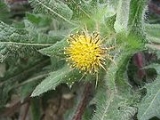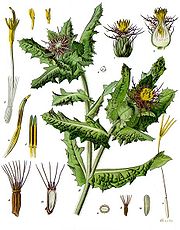
Cnicus
Encyclopedia
Cnicus benedictus was the sole species in the genus Cnicus, but has been reclassified as Centaurea benedicta. (Note, this is not the same as milk thistle.)
It is a thistle
-like plant in the family Asteraceae
, native to the Mediterranean region, from Portugal
north to southern France
and east to Iran
. It is known in other parts of the world, including parts of North America, as an introduced species
and often a noxious weed.
growing to 60 cm tall, with leathery, hairy leaves
up to 30 cm long and 8 cm broad, with small spines on the margins. The flower
s are yellow, produced in a dense flowerhead
(capitulum) 3-4 cm diameter, surrounded by numerous spiny basal bract
s.
The related genus Notobasis
is included in Cnicus by some botanists; it differs in slender, much spinier leaves, and purple flowers.
. The crude extracts contain about 0.2% cnicin
. It is recommended for use by public health nurses in Ontario, Canada, as well as by the Canadian Breastfeeding Foundation along with fenugreek
to increase lactation in nursing mothers. It is also a component in some bitters
formulas.
, Arctium and Onopordum
species; the leaves are considered unpalatable if not bitter.

It is a thistle
Thistle
Thistle is the common name of a group of flowering plants characterised by leaves with sharp prickles on the margins, mostly in the family Asteraceae. Prickles often occur all over the plant – on surfaces such as those of the stem and flat parts of leaves. These are an adaptation that protects the...
-like plant in the family Asteraceae
Asteraceae
The Asteraceae or Compositae , is an exceedingly large and widespread family of vascular plants. The group has more than 22,750 currently accepted species, spread across 1620 genera and 12 subfamilies...
, native to the Mediterranean region, from Portugal
Portugal
Portugal , officially the Portuguese Republic is a country situated in southwestern Europe on the Iberian Peninsula. Portugal is the westernmost country of Europe, and is bordered by the Atlantic Ocean to the West and South and by Spain to the North and East. The Atlantic archipelagos of the...
north to southern France
France
The French Republic , The French Republic , The French Republic , (commonly known as France , is a unitary semi-presidential republic in Western Europe with several overseas territories and islands located on other continents and in the Indian, Pacific, and Atlantic oceans. Metropolitan France...
and east to Iran
Iran
Iran , officially the Islamic Republic of Iran , is a country in Southern and Western Asia. The name "Iran" has been in use natively since the Sassanian era and came into use internationally in 1935, before which the country was known to the Western world as Persia...
. It is known in other parts of the world, including parts of North America, as an introduced species
Introduced species
An introduced species — or neozoon, alien, exotic, non-indigenous, or non-native species, or simply an introduction, is a species living outside its indigenous or native distributional range, and has arrived in an ecosystem or plant community by human activity, either deliberate or accidental...
and often a noxious weed.
Growth
It is an annual plantAnnual plant
An annual plant is a plant that usually germinates, flowers, and dies in a year or season. True annuals will only live longer than a year if they are prevented from setting seed...
growing to 60 cm tall, with leathery, hairy leaves
Leaf
A leaf is an organ of a vascular plant, as defined in botanical terms, and in particular in plant morphology. Foliage is a mass noun that refers to leaves as a feature of plants....
up to 30 cm long and 8 cm broad, with small spines on the margins. The flower
Flower
A flower, sometimes known as a bloom or blossom, is the reproductive structure found in flowering plants . The biological function of a flower is to effect reproduction, usually by providing a mechanism for the union of sperm with eggs...
s are yellow, produced in a dense flowerhead
Inflorescence
An inflorescence is a group or cluster of flowers arranged on a stem that is composed of a main branch or a complicated arrangement of branches. Strictly, it is the part of the shoot of seed plants where flowers are formed and which is accordingly modified...
(capitulum) 3-4 cm diameter, surrounded by numerous spiny basal bract
Bract
In botany, a bract is a modified or specialized leaf, especially one associated with a reproductive structure such as a flower, inflorescence axis, or cone scale. Bracts are often different from foliage leaves. They may be smaller, larger, or of a different color, shape, or texture...
s.
The related genus Notobasis
Notobasis
Notobasis syriaca , syn. Cirsium syriacum, Cnicus syriacus), the sole species in the genus Notobasis, is a thistle-like plant in the family Asteraceae, native to the Mediterranean region and the Middle East, from Madeira, the Canary Islands, Morocco and Portugal east to Egypt, Iran and...
is included in Cnicus by some botanists; it differs in slender, much spinier leaves, and purple flowers.
Medicinal uses
It has sometimes been used as a galactogogue to promote lactationLactation
Lactation describes the secretion of milk from the mammary glands and the period of time that a mother lactates to feed her young. The process occurs in all female mammals, however it predates mammals. In humans the process of feeding milk is called breastfeeding or nursing...
. The crude extracts contain about 0.2% cnicin
Cnicin
Cnicin is a sesquiterpene lactone, esterified with a substituted acrylic acid, and belonging to the germacranolide class of natural products. It is mainly found in Cnicus , and is present in spotted knapweed plants, where highest and lowest concentrations are found in the leaves and stems...
. It is recommended for use by public health nurses in Ontario, Canada, as well as by the Canadian Breastfeeding Foundation along with fenugreek
Fenugreek
Fenugreek is a plant in the family Fabaceae. Fenugreek is used both as a herb and as a spice . The leaves and sprouts are also eaten as vegetables...
to increase lactation in nursing mothers. It is also a component in some bitters
Bitters
A bitters is an alcoholic beverage that is flavored with herbal essences and has a bitter or bittersweet flavor. There are numerous brands of bitters that were formerly marketed as patent medicines but are now considered to be digestifs, rather than medicines...
formulas.
Edibility
These thistles are not considered edible, unlike CirsiumCirsium
Cirsium is a genus of perennial and biennial flowering plants in the Asteraceae, one of several genera known commonly as thistles. They are more accurately known as Plume thistles. These differ from other thistle genera in having feathered hairs to their achenes...
, Arctium and Onopordum
Onopordum
Onopordum L. is a genus of about 40 species of thistles belonging to the family Asteraceae, native to Europe , northern Africa, the Canary Islands, the Caucasus, and southwest and central Asia...
species; the leaves are considered unpalatable if not bitter.

External links
- Cnicus Benedictus.—Blessed Thistle
- Spotted thistle entry in the public domain NCI Dictionary of Cancer Terms

